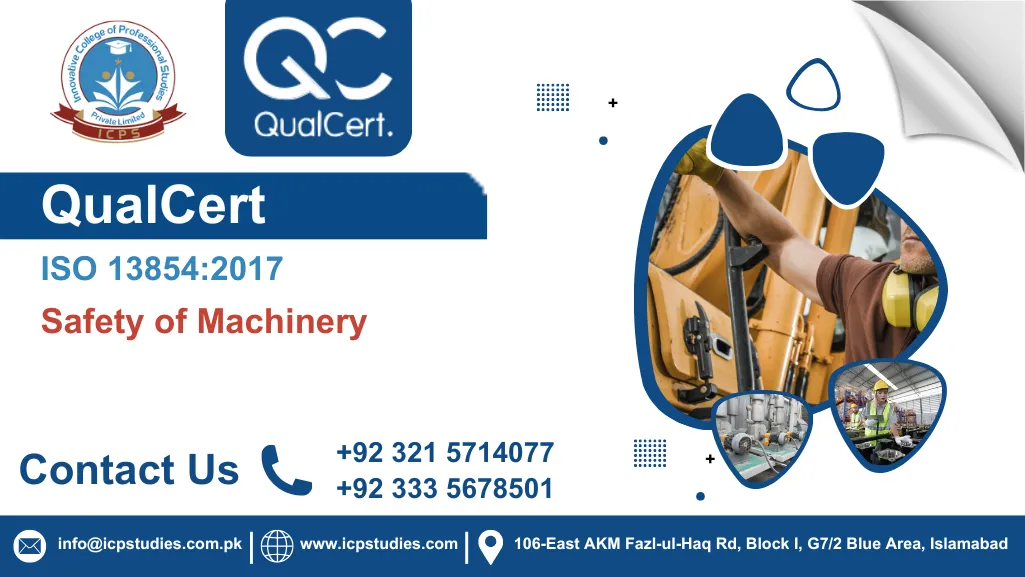The QualCert ISO 13854:2017 Safety of Machinery course has been designed to provide learners with a comprehensive understanding of the international standard that governs the minimum gaps required to prevent crushing hazards in machinery. This standard is a cornerstone of workplace safety, ensuring that equipment is designed and operated in a way that protects workers from mechanical risks. Through this course, participants will explore the principles behind ISO 13854:2017, the rationale for its requirements, and the practical applications across a wide range of industrial sectors. The training emphasizes both theoretical knowledge and practical awareness, enabling learners to interpret the standard effectively and apply it to real-world machinery safety scenarios.
Learners will gain insight into the technical definitions, measurement criteria, and compliance obligations that underpin ISO 13854:2017. The course highlights how these requirements integrate into broader occupational safety frameworks and how organizations can implement them to reduce accidents and improve operational reliability. By examining case studies, industry examples, and best practices, participants will develop the ability to identify hazards, assess risks, and recommend corrective measures aligned with the standard. This structured approach ensures that learners not only understand the text of the standard but also appreciate its significance in safeguarding human health and maintaining organizational credibility.
Completing QualCert ISO 13854:2017 Safety of Machinery demonstrates a commitment to professional development and workplace safety excellence. While it is not Ofqual regulated, successful learners will receive certification from QualCert, which can serve as a valuable addition to their professional portfolio. This certification can complement other industry-recognized diplomas and certifications in occupational safety, engineering, and risk management, reinforcing a learner’s expertise and employability. For professionals working in manufacturing, engineering, maintenance, or safety management, the QualCert ISO 13854:2017 Safety of Machinery course provides a strong foundation for advancing knowledge, supporting compliance, and contributing to safer, more efficient workplaces.
All About QualCert ISO 13854:2017 Safety of Machinery
Course Overview
The QualCert ISO 13854:2017 Safety of Machinery is a 30‑credit qualification designed to provide learners with a rigorous and practical understanding of international safety standards for machinery. With a Total Qualification Time (TQT) of 180 hours, including 120 Guided Learning Hours (GLH), the program balances structured instruction with independent study to ensure participants gain both theoretical knowledge and applied competence. This carefully developed framework allows learners to progress through the standard in a systematic way, building confidence in interpreting requirements and applying them to diverse industrial contexts.
The course is meticulously crafted to deliver focused and efficient skill development in the field of machinery safety. Learners will explore the principles of ISO 13854:2017, which sets out the minimum gaps required to prevent crushing hazards, and understand how these requirements integrate into wider occupational safety practices. By combining technical detail with practical application, the program equips participants to identify risks, evaluate compliance, and recommend improvements that enhance workplace safety. The structured learning hours ensure that learners benefit from guided instruction, while the additional study time allows for deeper reflection and consolidation of knowledge.
A key strength of this qualification lies in its emphasis on real‑world application. Learners will engage with case studies, industry examples, and scenario‑based exercises that highlight the importance of ISO 13854:2017 in everyday operations. This approach ensures that participants not only understand the standard itself but also develop the ability to apply it effectively in manufacturing, engineering, and maintenance environments. The program encourages critical thinking, problem‑solving, and practical awareness, making it highly relevant for professionals seeking to strengthen their expertise in machinery safety and compliance.
Upon completion, learners will receive certification from QualCert, demonstrating their achievement and commitment to professional development in this specialized area. While not Ofqual regulated, the qualification carries significant value as a recognized credential that can complement other industry certifications and diplomas. It provides a strong foundation for career progression in occupational safety, engineering, and risk management, and reinforces an individual’s credibility in promoting safe and efficient workplace practices. The QualCert ISO 13854:2017 Safety of Machinery course is therefore an essential step for professionals aiming to enhance their knowledge, skills, and impact in the field of machinery safety.
To enroll in the QualCert ISO 13854:2017 Safety of Machinery course, learners are expected to meet the following criteria:
- Age Requirement: Participants should normally be 18 years or older to ensure maturity and readiness for professional-level study.
- Educational Background: A minimum of secondary education is recommended, with preference for learners who have completed diplomas or certificates in engineering, occupational safety, or industrial technology. Related qualifications such as workplace safety diplomas, mechanical engineering certificates, or risk management awards provide a strong foundation.
- Language Proficiency: Learners must demonstrate proficiency in English, as all course materials, assessments, and discussions are delivered in English. Clear communication skills are essential for understanding technical standards and applying them effectively.
- Work Experience: While not mandatory, prior experience in manufacturing, engineering, or safety management is advantageous, as it allows learners to contextualize the requirements of ISO 13854:2017 within real-world operations.
This course is designed to be accessible yet rigorous, ensuring that learners with the right educational background and professional interest can successfully engage with the material and apply it to their workplace practices.
The ideal learner for the QualCert ISO 13854:2017 Safety of Machinery course is someone committed to advancing their expertise in machinery safety, compliance, and workplace risk management. This profile reflects the skills, interests, and professional attributes that align with the demands of the program.
Professional Orientation
- Works in manufacturing, engineering, maintenance, or occupational safety roles
- Seeks to strengthen knowledge of international safety standards
- Values compliance and operational efficiency in industrial settings
- Interested in applying technical standards to practical workplace scenarios
- Motivated to enhance career progression through recognized certification
Technical Competence
- Familiar with machinery operations and mechanical systems
- Understands basic engineering principles and workplace safety practices
- Able to interpret technical documents and apply them to real-world contexts
- Comfortable with measurements, risk assessments, and compliance checks
- Keen to develop advanced skills in hazard identification and prevention
Learning Approach
- Demonstrates strong analytical and problem-solving skills
- Engages actively with structured learning and guided instruction
- Balances independent study with collaborative learning opportunities
- Applies theoretical knowledge to practical case studies and examples
- Values continuous professional development and lifelong learning
Communication Skills
- Proficient in English for reading, writing, and discussion
- Capable of presenting safety recommendations clearly and effectively
- Skilled in documenting compliance processes and reporting findings
- Able to collaborate with colleagues across technical and safety teams
- Appreciates the importance of clear communication in risk management
Commitment to Safety
- Prioritizes worker health and safety in all professional activities
- Understands the ethical responsibility of ensuring safe machinery use
- Seeks to reduce workplace accidents through proactive measures
- Values international standards as benchmarks for safety excellence
- Dedicated to promoting a culture of safety within organizations
Career Development Goals
- Aspires to strengthen professional credibility in safety and engineering fields
- Seeks certification that complements existing diplomas or certificates
- Interested in roles requiring compliance expertise and technical safety knowledge
- Motivated to contribute to organizational safety audits and inspections
- Committed to building a portfolio of recognized qualifications
The ideal learner is therefore someone who combines technical interest, professional ambition, and a strong commitment to workplace safety. This course provides them with the knowledge and certification to advance their career while contributing meaningfully to safer, more efficient industrial environments.
Study Units
- Fundamentals of Machinery Safety Regulations
- Safe Design Principles and Risk Reduction
- Protective Equipment and Guarding Systems
- Verification and Validation of Safety Features
- International Compliance Requirements for Machinery
- Maintenance and Management of Machinery Safety Systems
Learning Outcomes
By the end of the QualCert ISO 13854:2017 Safety of Machinery course, learners will have developed a comprehensive understanding of machinery safety standards, design principles, protective systems, compliance requirements, and maintenance practices. Each unit is carefully structured to build knowledge and practical competence, ensuring learners can apply international safety standards effectively in their professional environments.
Fundamentals of Machinery Safety Regulations
- Explain the scope and purpose of machinery safety regulations and their legal implications.
- Identify the responsibilities of manufacturers, employers, and operators under applicable safety laws.
- Understand the role of regulatory bodies, enforcement mechanisms, and compliance audits.
- Interpret relevant safety documentation, technical files, and standards applicable to machinery.
- Recognize how regulatory frameworks contribute to safer workplaces and reduced liability.
Safe Design Principles and Risk Reduction
- Apply fundamental principles of safe machinery design to minimize hazards during operation.
- Conduct structured risk assessments to identify, evaluate, and reduce potential machinery hazards.
- Integrate engineering controls, fail-safe mechanisms, and protective design elements into machinery.
- Balance safety requirements with functionality, productivity, and operational efficiency in design decisions.
- Recommend design modifications that align with international safety standards and best practices.
Protective Equipment and Guarding Systems
- Identify various types of protective equipment and guarding systems used in machinery safety.
- Understand selection criteria and proper application of guards, interlocks, and safety devices.
- Evaluate the effectiveness of guarding systems in preventing accidents and injuries.
- Ensure compliance with design, installation, and performance standards for protective equipment.
- Recommend improvements to guarding systems based on workplace risk assessments.
Verification and Validation of Safety Features
- Develop procedures for verifying and validating machinery safety features before use.
- Apply inspection, testing, and audit techniques to confirm safety system performance.
- Document verification and validation activities to demonstrate compliance with standards.
- Identify and address non-conformities or failures in safety features through corrective action.
- Establish continuous monitoring processes to ensure ongoing safety compliance.
International Compliance Requirements for Machinery
- Identify key international standards and regulations governing machinery safety.
- Understand how to apply global compliance requirements across different jurisdictions.
- Prepare machinery, documentation, and technical files for international market entry and certification.
- Monitor updates and changes in international safety standards to maintain compliance.
- Recognize the importance of harmonization between local and global safety requirements.
Maintenance and Management of Machinery Safety Systems
- Design and implement structured maintenance programs for machinery safety systems.
- Identify common maintenance issues that affect safety, reliability, and operational integrity.
- Manage safety system maintenance schedules, inspections, and record-keeping effectively.
- Promote a culture of safety through proactive management and continuous improvement.
- Evaluate maintenance practices to ensure alignment with international safety standards.
These learning outcomes ensure that learners completing the QualCert ISO 13854:2017 Safety of Machinery course are equipped with the technical knowledge, practical skills, and compliance awareness necessary to uphold the highest standards of workplace safety. The program provides a strong foundation for professional growth, enabling participants to contribute meaningfully to safer, more efficient, and internationally compliant industrial environments.
FAQs About QualCert ISO 13854:2017 Safety of Machinery

